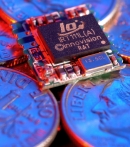With an eye to the emerging market for readers and tags using Near Field Communication (NFC) technology, as well as its existing transportation and healthcare RFID designs, Innovision Research & Technology (IR&T) has announced what it believes is the world’s smallest and lowest-costing 13.56 MHz RFID reader engine.
Smaller than a U.S. dime, the new reader engine (an RFID transceiver minus its antenna and power source) measures 12mm (0.47 inch) in width and length and 2mm (0.08 inch) in thickness and features an on-board RISC processor. According to IR&T, the readers small size and 2.8-volt power consumption making it ideal for small-footprint devices such as small, battery-powered handheld devices.
In January, RFID engineering company SkyeTek announced that it had developed the world’s smallest RFID reader, the SkyeRead M1-mini, measuring 1 inch in diameter and 0.1 inch in thickness. (See SkyeTek Shrinks the RFID Reader.)
Dubbed io, the tiny IR&T RFID engine adheres to the ISO14443A standard created for proximity cards. That means it can be used to read RFID tags made with IR&T’s own Jewel RFID microchip (see Chipping Away at Mag Stripes) and Philips Mifare Ultralight chip, both of which target the mass transit ticketing applications.
“This could enable conductors to interrogate contactless tickets using a handheld reader,” says Marc Borrett, managing director at IR&T, which is based in Wokingham, Berkshire, in the U.K.
However, IR&T maintains that the reader is also capable of being quickly adapted to support the planned next-generation RFID technology based around on NFC technology developed by consumer electronics giants Royal Philips Electronics and Sony and aimed at enabling short-range wireless interaction between specialized RFID tags, consumer electronics, mobile devices and PCs.
NFC technology is already standardized by ISO (18092), ECMA (340) and ETSI (TS 102 190). Operating at the 13.56 MHz frequency range, over a distance of a few centimeters, and with data rates of 106 kbits/s and 212 kbits/s, NFC is compatible with Philips’ MIFARE (ISO 14443A) and Sony’s FeliCa smart card protocols.
Launched in September 2002 by consumer electronics giants Royal Philips Electronics and Sony launched, NFC technology plans to create a common way for a whole range of NFC-equipped devices to use RFID-type connections to exchange data linked to any number of services. (See Sony, Philips Creating RFID Link.) IRT says it is supporting the forthcoming NFC-2 standard, which will add more functionality than the existing NFC-1 standard, which received approval from the International Organization for Standardization (ISO) when ISO adopted the 18092 standard in December 2003. It maintains that its io reader was developed with a modular approach that will allow it to incorporate NFC-2 by means of a software or hardware upgrade once NFC-2 is adopted.
In one potential use for NFC, according to IR&T, an MP3 player with a built-in io reader could download a sample track from a NFC-enabled poster advertising a new album—just by passing the player over the advertisement. The advantage of RFID for this technology, says Borrett, is that unlike other near-distance communications technologies such as Infrared or Bluetooth, smart NRF RFID tags such as the one on the music poster would not need any power supply because the data transmission would be powered by the reader.
According to IR&T, its io reader is significantly smaller that existing readers because its construction includes an on-board RISC processor. Incorporating the processor functionality on the same silicon as the RFID component allows its design to reduce the silicon footprint of io, the company explains, and therefore also its cost.
“To date manufacturers have used off the shelf chipsets and printed-out circuit boards to build readers. We have developed the io reader to be made almost entirely in silicon. That reduces both the size and the cost,” Borrett says. Depending on volume, according to the company, the io reader engine can be produced at a fraction of the cost of existing designs.
“Readers can be anything from a hundred dollars to a few thousand dollars. Io pricing will be dependant on volume, but we expect it to be well under $100,” Borrett says.
As with its other reader and chip designs, IR&T says it is looking to license the io reader to original device manufacturers and application developers looking to either incorporate the io design into their own products’ silicon or who wish to manufacture and sell the packaged IC.
According to IR&T, one such partner is already shipping a product integrating the io reader. However, it cannot reveal the customer nor the product or even the vertical market those products are set for sale in. It also says that contract limits the markets that IR&T can currently offer the io reader to be developed for but that the contract expires later this year when, IR&T says it will be able to license its design to any interested company.
Attend RFID Journal University
There are less than three weeks left until RFID Journal University in Chicago. This unbiased educational course, presented by RFID Journal and members of Auto-ID Labs, is designed to provide the fundamental understanding of RFID needed to begin a successful pilot.
Register
today, or
to learn more, visit RFID
U.


